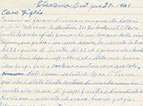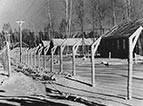The Internment Camps
In a concentration camp, I saw rich and poor thrown together in a pit of hell. All worried and sad that they had to make amends. I saw people of all sorts -- of different languages. I knew them, all good people, disbelieving their sad lot in life. On Sunday, kneeling, we listened to the divine word of Father [Benedetto Basilio] Maltempi, with the hope in our hearts to see family and spouses once again. A small group of friends, learned, comforted each other. All teachers and I, a professor, wanted to be called for our honour. Sad memories of Petawawa.
Emilio Galardo, internee, poem translated from Italian, 1940
We slept in huts and they would sleep about 60, I think. You had two or three big stoves in the middle. And we had it well organized. People that looked after the stove kept the fire going because it got awful cold out there. The cleaning was organized like the army. Who cleans the latrine, who sweep the floors...
Internee on life in the camps, Toronto, video interview, Columbus Centre Collection
There were 26 internment camps in Canada during World War II. Italian Canadian males were interned in three camps:
Kananaskis, Alberta
Built specifically for German Canadians in 1939, about 48 Italian Canadians from western Canada were sent to Kananaskis in June 1940. Communists from the region were also interned at this camp. Most of the Italian Canadians were later transferred to Petawawa, in July 1941. Internees Francesco Federici, Federico Ghislieri, Frederick Lenzi and Pietro Ruocco were released from Kananaskis.
Petawawa, Ontario
Built in 1904, Petawawa first served as a military training base. During World War I it functioned as an internment camp for German and Austrian Canadians. In 1939, the camp was used for the internment of enemy aliens. German, Italian and Japanese Canadians were held there at different times during the war. The majority of Italian Canadians from central and eastern Canada were sent to Petawawa in June 1940.
Fredericton/Ripples, New Brunswick
Initially built in July 1940, Italian Canadians still considered a threat by the RCMP were transferred to the Fredericton Internment Camp from Petawawa in July 1942. This camp was the only one of its kind in eastern Canada. The first internees were 517 Jewish refugees who had fled Nazi Germany for the United Kingdom. At the time, Winston Churchill questioned the loyalty of these refugees and sent them to Canada. They would later be released and replaced by German Canadians, and captured German and Italian merchant marines.



